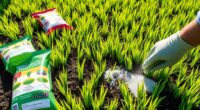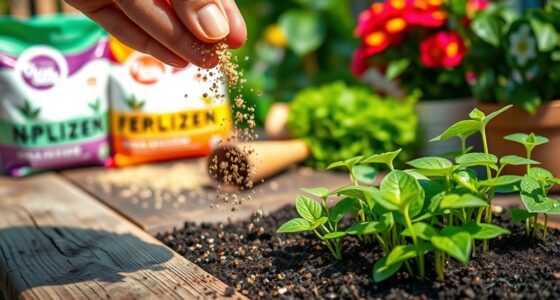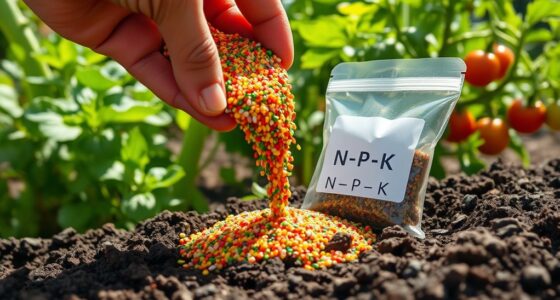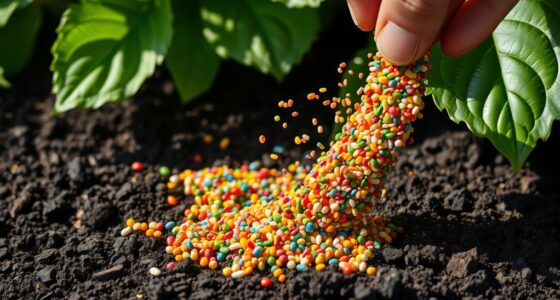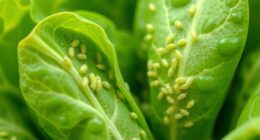Understanding N-P-K is key to giving your plants what they need. N-P-K stands for nitrogen, phosphorus, and potassium, the main nutrients in fertilizer. Nitrogen promotes lush green growth, phosphorus boosts roots and flowers, and potassium improves overall health and disease resistance. Choosing the right mix depends on your plants’ growth stage and soil condition. To maximize your garden’s potential, explore how balancing these nutrients can create healthier, thriving plants every season.
Key Takeaways
- N-P-K stands for nitrogen (N), phosphorus (P), and potassium (K), the primary nutrients in fertilizers.
- Nitrogen promotes leafy, green growth; phosphorus supports roots and flowering; potassium boosts overall plant health.
- Reading fertilizer labels helps determine the right N-P-K ratio for different plants and growth stages.
- Over-fertilizing can cause runoff and damage; under-fertilizing leads to nutrient deficiencies.
- Organic options and soil testing can guide effective, sustainable fertilizer use tailored to plant needs.
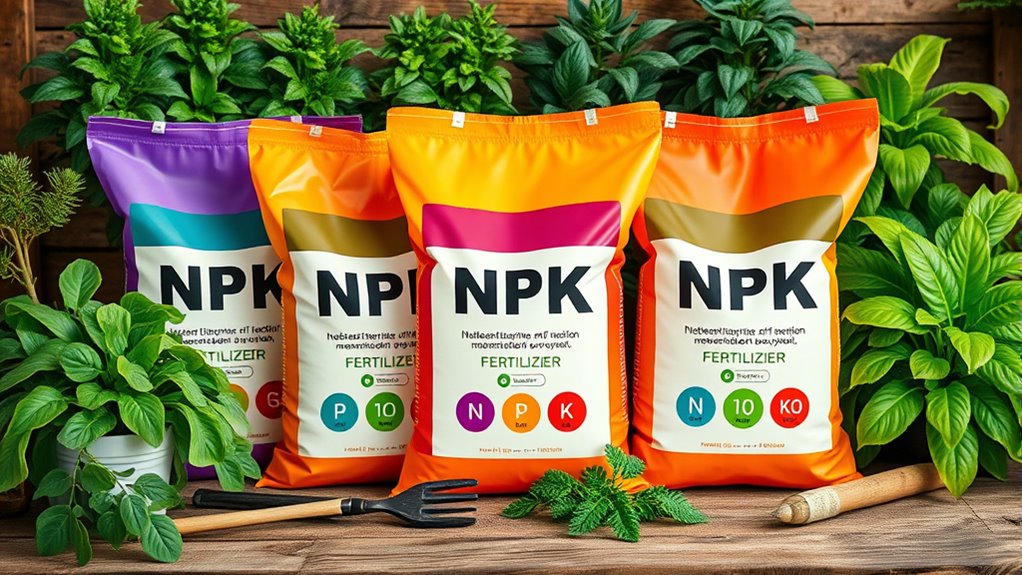
Ever wondered how plants grow so lush and healthy? It all comes down to understanding what they need to thrive, especially when it comes to fertilizers. One of the most important factors is soil health. Healthy soil acts as a foundation, providing the essential nutrients and environment for your plants to flourish. If your soil is depleted or poorly maintained, no amount of fertilizer will produce ideal growth. That’s why focusing on soil health is crucial—adding organic alternatives like compost, manure, or cover crops can boost soil fertility naturally. These options improve soil structure, increase microbial activity, and supply vital nutrients without the risks associated with chemical fertilizers. When you prioritize organic methods, you’re fostering a sustainable ecosystem that supports long-term plant health.
Knowing what your plants specifically need is just as important as maintaining healthy soil. Most fertilizers contain three primary nutrients: nitrogen (N), phosphorus (P), and potassium (K). These elements are essential for different aspects of plant development. Nitrogen promotes lush, green foliage; phosphorus encourages root growth and flowering; potassium enhances overall plant vigor and disease resistance. Understanding the balance of these nutrients helps you choose the right fertilizer for your plants’ growth stage and specific requirements. For example, leafy vegetables benefit from higher nitrogen levels, while flowering plants might need more phosphorus. Reading fertilizer labels and understanding the N-P-K ratio allows you to tailor your approach and avoid over- or under-fertilizing, which can harm your plants and the environment.
Applying the correct amount of fertilizer at the right time maximizes plant health and minimizes waste. Over-fertilizing can lead to nutrient runoff, pollution, and damaged roots, whereas under-fertilizing leaves your plants deficient and stunted. Incorporating fertilizers into your routine based on soil tests or plant indicators, and always following recommended application rates, is key. Organic alternatives like fish emulsion, seaweed extracts, or compost tea can provide nutrients gradually and sustainably. These organic choices not only nourish your plants but also improve soil structure over time, creating a healthy environment where roots can extend and absorb nutrients efficiently. Additionally, selecting appropriate organic techniques like cover cropping and crop rotation can further enhance soil vitality and productivity.
In the end, understanding soil health and choosing the right fertilizers—whether conventional or organic—empowers you to cultivate thriving, resilient plants. By balancing nutrients thoughtfully and caring for your soil, you’ll enjoy healthier gardens, abundant blooms, and lush greenery all season long.
Frequently Asked Questions
How Do I Choose the Right Fertilizer for My Specific Plants?
To select the right fertilizer for your plants, start by testing your soil to understand its nutrient levels. This helps you identify what your plants need most. Once you know the soil’s deficiencies, choose a fertilizer with the appropriate N-P-K ratio that matches your plants’ specific nutrient requirements. Regularly monitor your plants’ health and adjust fertilization as needed to ensure they grow strong and healthy.
Can Over-Fertilizing Harm My Plants or the Environment?
Imagine applying too much fertilizer to your garden, leading to plant toxicity and runoff into local waterways. Over-fertilizing can harm your plants by causing root burn and nutrient imbalance. It also risks environmental damage through fertilizer runoff, which contaminates water supplies and harms aquatic life. To avoid this, always follow recommended application rates, and it’s better to under-fertilize than to overdo it, keeping your plants healthy and the environment safe.
Are Organic Fertilizers as Effective as Synthetic Ones?
You might wonder if organic alternatives are just as effective as synthetic fertilizers. In many cases, they are, especially when used correctly, because organic options improve soil health and provide nutrients naturally. Synthetic comparisons often show faster results, but organic fertilizers promote long-term plant health and sustainability. Ultimately, your choice depends on your gardening goals, but rest assured, organic fertilizers can be just as impactful as synthetic ones.
When Is the Best Time to Fertilize Indoor Versus Outdoor Plants?
You should fertilize indoor plants during their active growth stages, usually spring and summer, with seasonal fertilization to support healthy development. For outdoor plants, time your fertilization based on their specific growth cycles and local climate conditions. Avoid over-fertilizing during dormancy periods. Adjust your schedule to match plant needs, ensuring they get the nutrients they require when they’re actively growing and thriving.
How Do Soil Ph Levels Affect Fertilizer Absorption?
Think of soil pH as a gatekeeper, controlling nutrient access like a bouncer at a club. Soil acidity or alkalinity directly impacts fertilizer absorption, determining nutrient availability for your plants. When pH levels are off, nutrients may become locked away or toxic. Keeping soil in the ideal pH range ensures your plants absorb the right nutrients, thriving like a well-fed crowd enjoying the perfect event.
Conclusion
Now that you understand the basics of N-P-K and your plants’ needs, you’re equipped to nourish them like a seasoned gardener. Think of fertilizers as the fuel that keeps your garden thriving, each nutrient playing its part like an orchestra. With this knowledge, you can tune your plants’ growth perfectly, ensuring they flourish and bloom. Your garden’s success is in your hands—so get ready to watch it blossom into a vibrant masterpiece!

